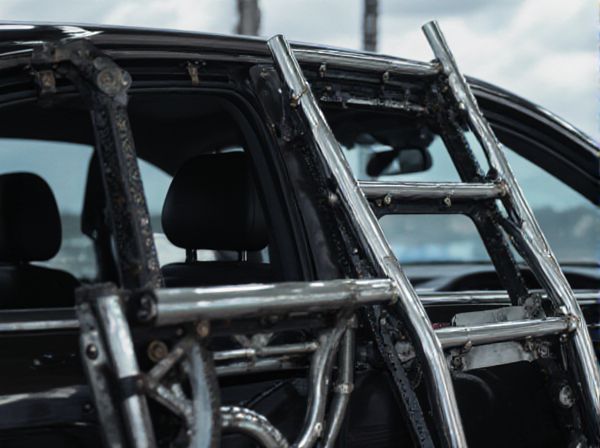
Photo illustration: Ladder Frame vs X-Frame
Ladder frames offer robust support and durability, making them ideal for heavy-duty vehicles and off-road conditions. X-frames provide enhanced torsional rigidity and improved weight distribution, resulting in better handling and ride comfort. Choosing the right frame depends on your vehicle's purpose and performance priorities.
Table of Comparison
| Feature | Ladder Frame | X-Frame |
|---|---|---|
| Design | Two parallel beams connected by cross members | Two beams crossed in an "X" shape for enhanced rigidity |
| Structural Strength | Good torsional rigidity, but less than X-Frame | Higher torsional strength due to cross-bracing |
| Weight | Heavier frame structure | Generally lighter due to design efficiency |
| Ride Comfort | More vibrations transmitted, less comfort | Improved cushioning, smoother ride |
| Manufacturing Complexity | Simple, cost-effective production | More complex and expensive to manufacture |
| Common Use | Trucks, SUVs, heavy-duty vehicles | Some classic cars, specific performance models |
Overview of Vehicle Frame Designs
Ladder frames consist of two parallel longitudinal beams connected by several lateral cross members, providing high strength and excellent load-bearing capacity ideal for trucks and SUVs. X-frames, characterized by a central X-shaped cross member bracing the chassis, offer enhanced torsional rigidity and reduced chassis flex, contributing to improved handling and ride quality in passenger cars. Both frame designs focus on structural integrity and weight distribution but cater to different vehicle performance and application requirements.
What is a Ladder Frame?
A ladder frame is a traditional vehicle chassis design consisting of two longitudinal steel beams connected by several cross members, resembling a ladder shape. It provides excellent strength and durability, making it ideal for heavy-duty trucks and off-road vehicles by distributing weight evenly and absorbing impacts. This frame type supports high load capacities and is easier to repair or modify compared to more complex chassis designs like the X-frame.
What is an X-Frame?
An X-frame is a vehicle chassis design characterized by two diagonal cross members forming an "X" shape for enhanced structural rigidity. This design improves torsional resistance compared to a traditional ladder frame, providing better handling and stability under stress. X-frames are commonly used in automotive applications that require a balance of strength and weight efficiency, particularly in older American cars from the mid-20th century.
Structural Differences Between Ladder and X-Frame
The ladder frame consists of two longitudinal beams connected by multiple cross members, providing a simple rectangular structure primarily designed for heavy-duty applications. In contrast, the X-frame features diagonal cross members forming an "X" shape, enhancing torsional rigidity and improving load distribution while reducing flex under stress. This structural difference allows the X-frame to offer superior resistance to twisting forces compared to the traditional ladder frame, making it suitable for vehicles requiring enhanced chassis stiffness.
Advantages of Ladder Frame Construction
Ladder frame construction offers superior strength and durability, making it ideal for heavy-duty vehicles and off-road applications. Its simple, robust design provides excellent load distribution and ease of repair compared to the more complex X-frame. This traditional frame type enhances towing capacity and chassis flexibility, supporting heavy payloads and rugged terrain performance.
Benefits of X-Frame Architecture
X-Frame architecture offers enhanced structural rigidity and improved torsional resistance compared to traditional ladder frames, leading to better overall vehicle stability and handling. This design reduces weight while maintaining strength, contributing to improved fuel efficiency and payload capacity. X-Frame's centralized load distribution also minimizes stress points, increasing durability and extending the lifespan of the chassis.
Common Applications: Ladder Frame vs X-Frame
Ladder frames are commonly used in trucks, SUVs, and heavy-duty vehicles due to their excellent strength and ability to handle heavy loads and rough terrain, making them ideal for off-road and commercial applications. X-frames are often found in some mid-20th century cars, providing increased torsional rigidity and resistance to twisting forces, which enhances ride quality and handling in passenger cars. The ladder frame excels in durability for rugged environments, while the X-frame supports lightweight construction with improved chassis stiffness in performance-oriented vehicles.
Durability and Safety Comparison
Ladder frames, known for their robust construction, provide excellent durability by effectively distributing weight and absorbing impact forces, making them ideal for heavy-duty vehicles and off-road use. X-frames offer enhanced structural rigidity by connecting frame rails with diagonal cross members, which improves torsional strength and safety in collisions by minimizing frame flex. While ladder frames excel in load-bearing capacity, X-frames deliver superior crash protection and stability, making the choice dependent on vehicle purpose and safety priorities.
Performance in Off-Road and On-Road Scenarios
Ladder frames provide superior durability and load distribution in off-road scenarios, enabling better resistance to twisting forces on rugged terrain. X-frames offer enhanced torsional rigidity and improved handling stability, making them more suitable for on-road performance with reduced body flex. Off-road enthusiasts often prefer ladder frames for their robustness, while X-frames cater to drivers prioritizing smooth and controlled on-road driving experiences.
Choosing the Right Frame for Your Vehicle
Choosing the right frame for your vehicle depends on factors such as load capacity, off-road capability, and structural rigidity. Ladder frames offer superior durability and load-bearing strength, making them ideal for trucks and heavy-duty vehicles, while X-frames provide enhanced torsional stiffness and weight savings suited for performance and passenger cars. Evaluating your vehicle's intended use, including terrain and payload requirements, ensures optimal frame selection for safety and efficiency.
 caratoz.com
caratoz.com